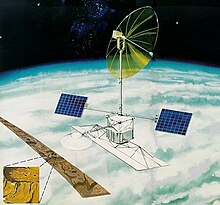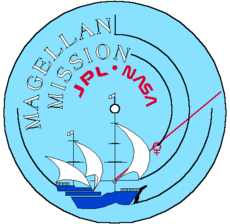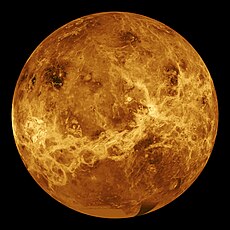Magellan (probe)
Magellan was an American space probe that was active between 1989 and 1994 and used as an orbiter to explore Venus .
mission
Under the name Venus Orbiting Imaging Radar (VOIR) and Venus Radar Mapper (VRM), considerations for a detailed mapping of Venus with the help of radar had already begun in the 70s and 80s , but these were rejected by the US government as too expensive. Under the name Magellan , named after the Portuguese explorer of the 16th century (first circumnavigation), an inexpensive mission was finally planned in which the probe only carried the Synthetic Aperture Radar (SAR). From a technical point of view, the probe was a hodgepodge of spare and replacement parts from previous missions ( Mariner 9 , Voyager program , Galileo , Ulysses ).
Previous radar maps of Venus were:
- Venera 9 and 10 ( USSR ) 1975 for test only.
- Pioneer-Venus 1 (USA) 1978 with an average resolution of 20,000 meters per pixel (picture element).
- Venera 15 and 16 (USSR) 1983 with an average resolution of 1,500 meters per pixel, but only the northern hemisphere up to about 30 degrees north latitude and thus about 30% of the surface.
In contrast, Magellan had an average resolution of 100 meters per pixel, which is an increase by a factor of 200 compared to the Pioneer Venus 1 and at least a factor of 15 compared to the Venera 15 and Venera 16 .
construction
The Magellan probe was a three-axis stabilized spacecraft. Both the main structure (bus) and the main antenna consisted of leftover parts of the Voyager program . The parabolic antenna served both as an antenna for the SAR and as a communication antenna. Next to the main antenna was a horn antenna of the altimeter . The Magellan probe had eight small thrusters to correct the orbit. A Star 48 launchable rocket motor fired the probe into Venus' orbit. Two swiveling solar cell arms , which were unfolded before leaving the earth orbit, supplied the probe with energy.
course
- Magellan was launched on May 4, 1989 from the Space Shuttle Atlantis using an IUS rocket stage.
- The probe entered orbit around Venus on August 10, 1990 .
- The radar mapping ran from 1990 to 1992.
- In 1993 NASA tested the so-called aerobraking maneuver with Magellan, the braking of a probe by flying through the upper layers of the atmosphere of a planet. It also made it possible to draw conclusions about the density and composition of the gas envelope.
- Magellan burned up in the atmosphere of Venus on October 12, 1994.
Result
Magellan supplied the map of Venus, which has been considered the standard work since then, a total of around 98% of the surface from 89 ° north to 89 ° south was recorded. The image of Venus on this page was created from Magellan's radar data .
See also
Web links
- The Magellan space probe (Ger.)
- Historic home of Magellan at JPL (Engl.)
- The Magellan Venus Explorer's Guide - Highly detailed Mission Briefing (Engl.)
- Internet Archive: Frederick Soup: Venus Alive! History of the origins of the Magellan probe and the VOIR project ( Memento from April 24, 2003 in the Internet Archive ) (English; PDF file; 2.47 MB)
- Internet Archive: Frederick Soup: Venus Alive! The Magellan probe explores Venus ( Memento of April 24, 2003 in the Internet Archive ) (English; PDF file; 3.1 MB)
- "Magellan: The Unveiling of Venus," (JPL-400-345, 1989), at NASA History Online
- The book: John P. Ford et al .: Guide to Magellan Image Interpretation , (JPL-93-24), at NASA History Online





